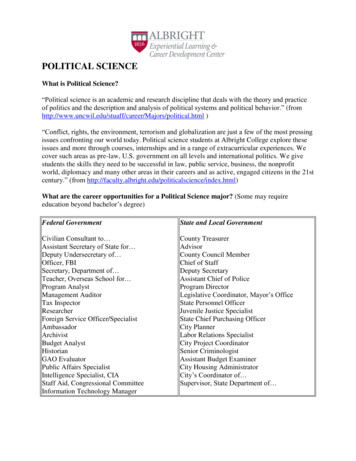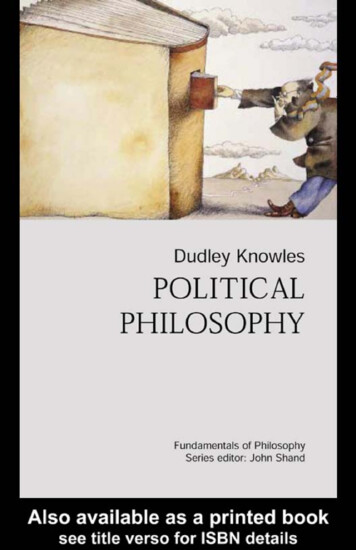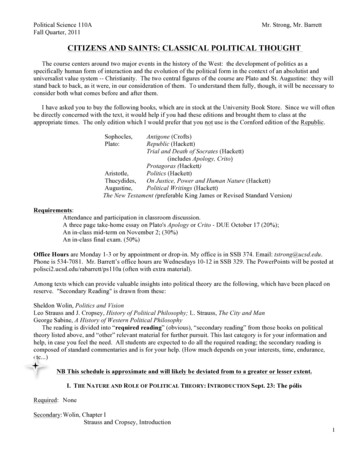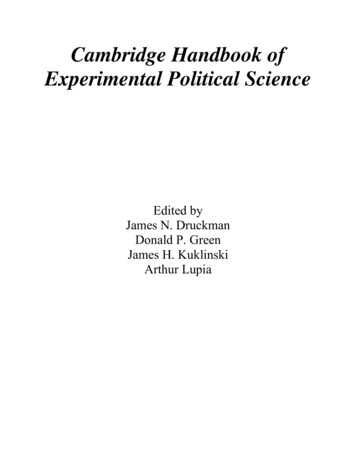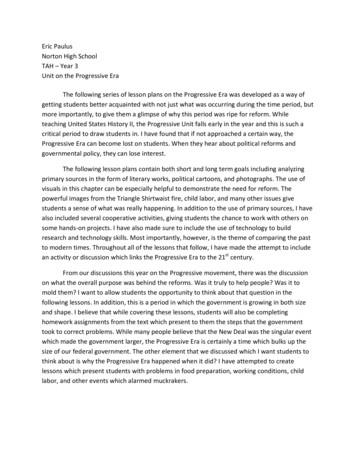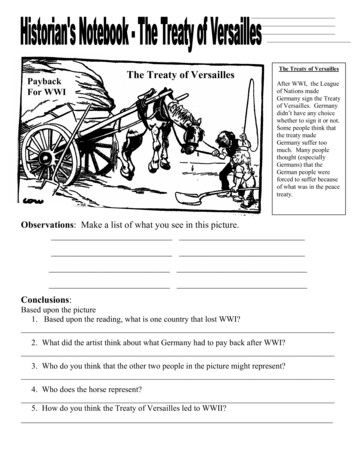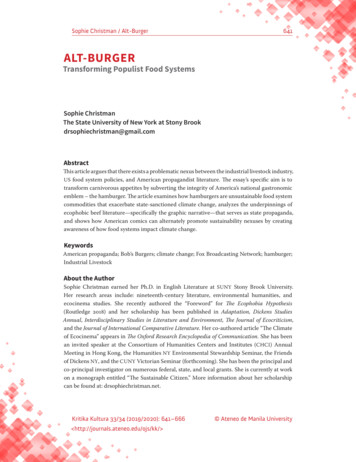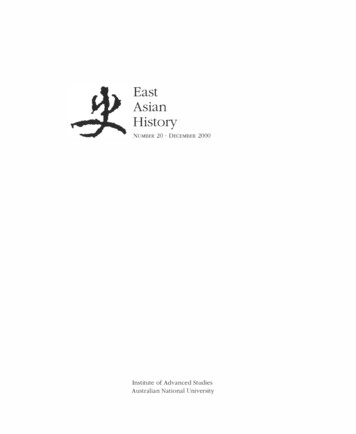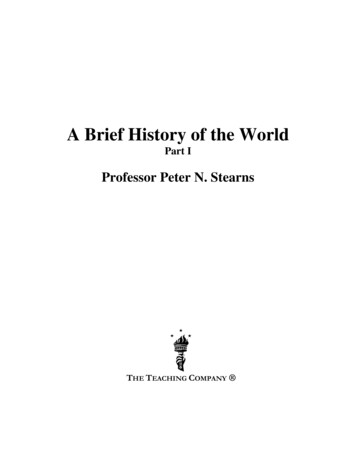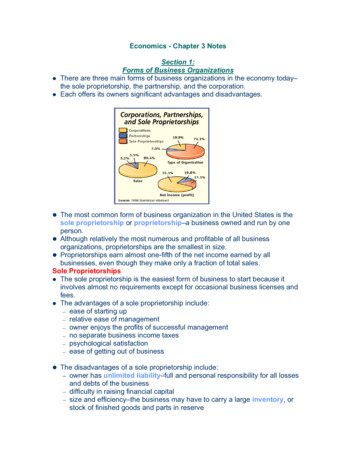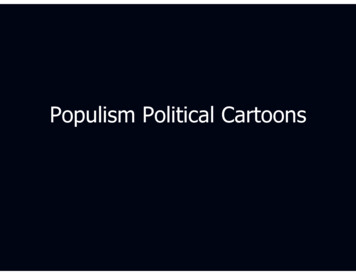
Transcription
Populism Political Cartoons
Populists' major complaint was that politicians and Wall Street heldthe "people" down by manipulating the political system. Thisproblem could be solved by a "rising of the people" that wouldrestore popular control of government.
Farmers and laborers (especially miners) proved to be thePopulist Party's strongest supporters. In this cartoon, thefruits of their labor are being stolen by financial intereststhrough foreclosures, interest, rents, etc.
Populists defended the original meaning of America -- a place whererelatively equal small producers dominated. Monarchy, aristocracy,and other forms of privilege constituted a negative counter-image toAmerican republicanism in Populist eyesThe caption at the bottom of thiscartoon reads:George Washington (Farewell Address)-- "We should look to the future for apower not of the people (plutocracy)may seek to destroy this freegovernment. Eternal vigilance is theprice of liberty."Thomas Jefferson (Democrat 1801) -"All men being created free and equal,it is therefore a fundamental principleof this government to guarantee equalrights to all and special privileges tonone."Abraham Lincoln (Republican 1860) -"A government by the people, for thepeople and of the people shall notperish from the earth."Plutocracy (1896) -- "Them fellowswere foolish to believe that they couldkeep me off this throne."
Populists opposedthe rising gapbetween rich andpoor that developedduring latenineteenth centuryAmerica. Talent andhard work alonecould not explain thedifferences. Thus,Populistssuspected that therich had gottenaheadthrough illegitimatespecial privileges.
Populists feared that concentration of wealth would destroy theeconomic independence that Americans needed to be political freeagents. European-style monarchy constituted the major threat toAmerica's democratic institutions during the nineteenth century.
Populists argued that all value came from the physical labor involvedin creating a product. This is called the labor theory ofvalue. Landlords and other exploiters were viewed as obtaining theirwealth illegitimately.
Farmers particularly complained about middlemen profits. Accordingto the labor theory of value, middlemen were exploiters rather thanproducers.
Populists claimed that Democratic and Republican politicians agitatedmeaningless issues, such as tariff revision, in demagogic attempts todivert people's attention from the real problems that producers faced.
Mainstream politicians, in turn, were controlled by specialinterests (particularly financial interests), according toPopulists.
In this illustration, Christ, who overturned the money changers tablesin the house of the Lord, evicts financial interests from Congress.
Populists leaders believed that once people had been educated as to thecauses of their plight they would join the People's Party. The SouthernFarmers Alliance (which spread throughout the South in 1886 and to thePlains States and West about 1890) was a forerunner of the Populist Party.
Educating farmers in thepolitically neutral SouthernFarmers' Alliance setting wascrucial to building the People'sParty. Late 19th centurypolitics was highly partisanand loyalties werestrong. Direct appeals frompartisans of another partyusually were dismissedwithout much of ahearing. The Farmers' Alliancebecame a valuable waystation between a voter's oldparty and Populism. TheFarmer’s Alliance isrepresented in the center,flanked by a RepublicanPolitician and a DemocraticPolitician.
Populist cartoonistsloved to use the"enemy's" own wordsagainst them. In1891, the People'sParty replacedRepublican John J.Ingalls with farmeditor William A.Peffer as U.S. Senatorfrom Kansas.
Populists saw their party as a tool for bringing relief to the laboringmasses. "Non-Interest Bond" was a euphemism for greenbacks (papermoney not backed by silver or gold), which Populists advocated.
The People's Party nominated ex-Union Gen. James B. Weaver and exConfederate Gen. James G. Field for president and vice president in 1892. TheBlue-Gray ticket symbolized the Populist attempt to overcome the Civil Warand Reconstruction animosities that Democrats and Republicans hademployed to maintain loyalty to their parties (the “Bloody Shirt”).
The 1892 Omaha Platform of the People's Party quickly became the Bible ofPopulism. The land, transportation, and money planks formed a trinity of theparty's most important issues. Here, the land speculator is portrayed as thesource of poverty and crime among those he has dispossessed.
The Omaha Platformcalled forgovernmentownership ofrailroads,telephones, andtelegraphs. Thepreamble to theplatform stated that"the railroadcorporations willeither own thepeople or the peoplemust own therailroads." Populistsbelieved that thepower monopoliesconferred upon theirowners constituted athreat to Americanliberties.
Money proved to be the Populist Party's most important issue. Latenineteenth century America suffered massive deflation. This particularly hurtdebtors, like farmers in the South and West. Populists called for bothgreenbacks and "free silver" as anti-deflation measures.
Populists looked to three events that rigged the monetary system against debtors - establishment of the National Banking System in 1863, removal of silver dollarsfrom the list of coins to be minted in 1873, and repeal of the Sherman SilverPurchase Act in 1893.
The Omaha Platform called for abolition of the National BankingSystem (which allowed bankers to control monetary policy) andestablishment of government-operated Postal Savings Banks.
As an electoral strategy,Populists attempted to formseveral coalitions. Thesouthern and westernsections of the nation hadsimilar debtoreconomies. Inhabitantsbelieved that railroads andnortheastern financialinterests unfairly exploitedthem. Civil War andReconstruction animositieswere the most importantobstacle to cooperationbetween these sections(the West was settledmostly bynortherners). Still, thisproved to be the Populist'smost successful coalition.
Populists also contended thatfarmers and laborers commonstatus as producers made themnatural allies. Here, members ofthe Knights of Labor, FarmersAlliance, and other similarorganizations rallytogether. This coalition workedwell in the South and Westwhere both groups largely camefrom the same ethnic group. Theparty appeared to make someheadway in the heavily-ethnicNortheast and Midwest in themid-1890s.
Populists also called for cooperation between impoverished black andwhite southerners. Racism was the biggest obstacle. The DemocraticParty was the contemporary party of racism and used the issueunmercifully to maintain its dominance of southern politics in the 1890s.
The most important impediment to all American third parties has been theargument that voters who leave their old party are only throwing the electionto the other mainstream party. Because the argument probably swayed manyvoters, Populist sentiment almost certainly was greater than voting for thePeople's Party indicated.
Shortly after Grover Cleveland became president in 1893, America's second worstdepression began. At its worst, between 15%-20% of the work force wasunemployed and many farm products sold for less than the cost ofproduction. Many considered President Cleveland's response tobe inadequate. John G. Carlisle (holding the bull's tail) was Cleveland's Secretaryof the Treasury.
Northeastern financialinterests (andpoliticians) convincedPresident Cleveland thata decline in investorconfidence had causedthe Panic of 1893. Theproblem, they claimed,was an outflow of gold inforeign exchangepayments caused by theSherman Silver PurchaseAct of 1890. Clevelandpromptly forced repeal ofthe Sherman Act, whichmade the free (untaxed)and unlimited coinage ofsilver at a ratio of 16 to 1(the pre-1873 ratio) thebiggest political issue ofthe era. Repeal probablycaused even greaterdeflation.
Repeal of the ShermanSilver Purchase Act washighly unpopular in theSouth andWest. Although manyDemocrats andRepublicans in theregions favored "freesilver," only the People'sParty had endorsed themeasure in its 1892platform. Populistsexpected the "free silver"issue to spur majorgrowth in their party andbegan to emphasize it.
After repeal of the Sherman Silver Purchase Act, the ClevelandAdministration floated a bond issue. Populists charged this was aconspiracy to enrich favored classes, especially English investors.
As the Panic of 1893 deepened, faith in the ClevelandAdministration's anti-depression measures declined, and Populistsentiment grew.
Unemployment, labor conflict, and destitution were rampant by1894. Many believed that apocalypse was near.
As "free silver" became the biggest issue of the era, Populists expected tobenefit from repeal of the Sherman Act. In this cartoon, the Democratic andRepublican parties are portrayed as Cinderella's two ugly sisters.
Even with the reducedvoter turnout of an offyear election, thePopulist vote increasedby more than 40% in1894. Democratic partylosses werecatastrophic. But, theRepublican Partyactually gained controlof the U.S. House ofRepresentatives withthis election. The smallPopulist contingent heldthe balance of power inthe Senate.
With the 1894Congressional elections,the Democratic Partycollapsed in theWest. The RepublicanParty did the same in theSouth. The People'sParty became the mainopponent to thedominant mainstreamparty in both sections. Afluid three-way politicalstruggle for powerseemed probable for theall important 1896general election.
Reformers believed that a major shift in the American political and economicsystem was imminent in 1896. Many believed that a coalition of reformersunder the People's Party banner could win the crucial 1896 election.
Populists decided to holdtheir national conventionafter those of theDemocratic and Republicanparties in 1896. Theyhoped to pick up thesupport of thosedisenchanted with their oldparty's pro-goldstance. Republicanspredictably nominatedWilliam McKinley forpresident and endorsed thegold standard. Democrats,however, bolted fromCleveland's dominance andnominated WilliamJennings Bryan forpresident on a "free silver"platform. This leftPopulists with little choicebut to support theDemocratic nominee, orsplit the pro-silver forces.
Populists generally fell into twogroups: fusionists and middleof-the-roaders. In 1896,fusionists (mostly westerners)wanted to unite pro-silverforces and form a coalition withWilliam Jennings Bryan and theDemocrats. Mid-roaders(mostly southerners) opposedveering off the road to reformfor expedient coalition victoriesand advocated a straightPopulist ticket. Bryan'sDemocratic running mate,Arthur M. Sewall, was a bankerand capitalist from Maine. Thismade him particularlyobnoxious to Populists, andgave mid-roaders a strongargument against endorsingthe Democratic ticket. In theend, the People's Partynominated Bryan for Presidentand Populist Thomas E. Watsonfor vice president. It lookedlike a compromise, but reallypleased very few.
Bryan, TheDemocratic/Populistcandidate for presidentlost a close race in1896. The People's Partydeclined rapidly after(perhaps during) thecampaign. One reasonwas the severe splitbetween fusionists andmid-roaders. This divisionbroke the most successfulof Populism's threeelectoral coalitions(westerners andsoutherners). After 1896,the two groups heldseparate conventions andthe People's Party spentmost of its energy oninternal recriminations,which tore the party apart.
The return to prosperity after 1896 also played a role in Populism's demise. The People'sParty had gained some of its support through criticizing Cleveland's anti-depressionmeasures. This 1898 cartoon suggests the return to prosperity was not as rapid nor asuniform as mainstream politicians claimed. Still, the economic turnaround did helpdefuse some Populist criticism.
The patriotism of the Spanish-American War of 1898 also played a role indestroying Populism. Criticism of the nation's leaders or institutions can bepainted as evidence of disloyalty by opponents during wartime. Thus,reformers usually mute their criticism or are silenced during periods ofinternational turmoil. Most Populists probably supported freeing Cuba fromautocratic Spanish rule.
The United States gainedan empire in1898. Puerto Rico,Hawaii, and thePhilippine Islandsbecame possessions,and Cuba became aprotectorate. Thus, theU.S. assumed the role oftutelage in the ways ofstatecraft for these socalled "inferior"peoples. As proponentsof the Founding Fathers'anti-colonialism, mostPopulists opposedimperialism. Thenationalistic prideinvolved in empirebuilding, however,served to mute manyreformers.The People's Party didvery poorly in the 1898Congressional elections,and virtuallydisappeared afterward.
The Populist MovementFarmers’ hardships Crop prices were falling, andfarmers had to repay loans.Railroads were charging highfees for transportMerchants made money fromfarm equipment.Everyone made money but thefarmer doing the workOutraged farmers organized tohelp themselves.Local groups formed to aidfarmersThe National Grange First major farmers’ organization Campaigned to unite farmersfrom all over As membership grew, pushed forpolitical reform and targetedrailroad rates Munn v. Illinois gave statelegislatures the right to regulatebusinesses that involved thepublic interest.Wabash v. Illinois—federalgovernment could regulaterailroad traffic.
The Alliance Movement and money supplyThe Farmers’ Alliance helped with practical needs such asbuying equipment or marketing farm products. They alsolobbied for banking reform and railroad rate regulation.In the South, the Colored Farmers’ Alliance formed. Withmore than 1 million members, the Alliance advocated hardwork and sacrifice as keys to gaining equality in society.The Alliances felt that an expanded money supply wouldhelp farmers by inflating prices, with inflation easingfarmers’ debt burden. Money was tied to the gold standard,and farmers wanted it to be backed by silver as well. Nowpolitically active, candidates supported by the Alliance wonmore than 40 seats in Congress and four governorships.
The Populist PartyEncouraged by their clout in national elections, the Alliancedecided to form a national political party. The Peoples’ Partywas born in Nebraska in July 1892. This coalition of farmers,labor leaders, and reformers became known as the PopulistParty. Party Platform—Supported the National Grange and Alliancedemands, with a platform calling for an income tax, bankregulation, government ownership of railroad and telegraphcompanies, and free coinage of silver.1892 election—Speaking for the common people against theruling elite, the Populists took several state offices and wonseats in Congress.
Economic Depression and a New ElectionThe Panic of 1893 The nation plunged intoanother depression,investors pulled out of thestock market, andbusinesses collapsed.Cleveland focused on silveras a cause of the nationaldepression. When silverdecreased in value, peoplerushed to exchange papermoney for gold.Cleveland called forCongress to repeal theSherman Silver PurchaseAct. The country stayed onthe gold standard.The election of 1896 William McKinley, a believer in thegold standard, was theRepublican nominee, and theDemocratic candidate was WilliamJennings Bryan. Bryan hailed the free coinage ofsilver as the key to prosperity. The Populists threw their supportto Bryan. McKinley won the election, andthe Populist Party soon fadedaway. But the groundwork forreform was laid.
Civil War and Reconstruction animosities were the most important obstacle to cooperation between these sections (the West was settled mostly by northerners). Still, this proved to be the Populist's most successful coalition.
